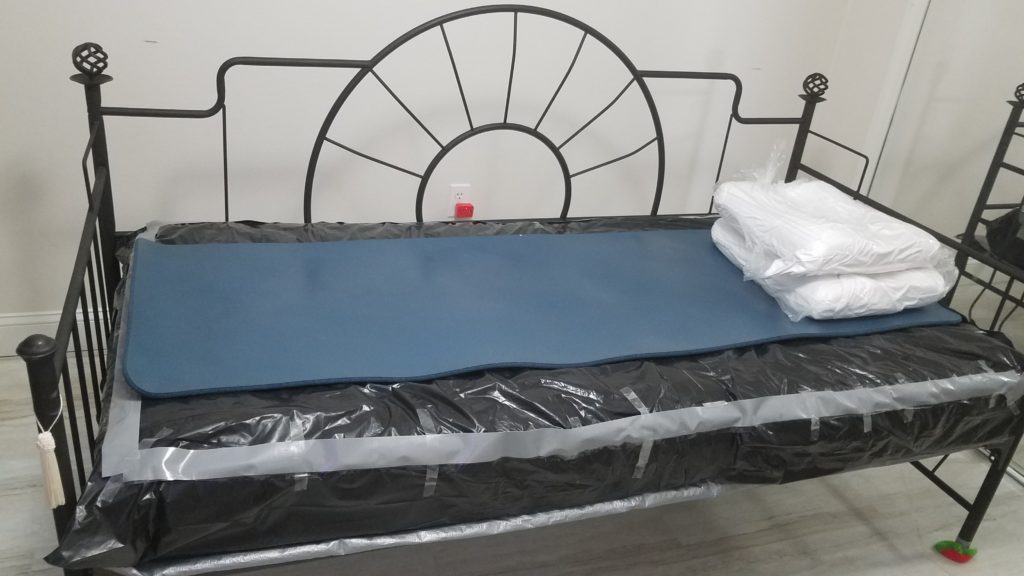Eradicating Mites from Your Environment

Having a bird mite affliction is like having cancer on both the inside and the outside of your body, and being forced to fight it simultaneously without the help of a doctor. There were so many times I wished I had an affliction that the medical community would acknowledge! This was my bed for the better part of 6 months! Looks like a prison, doesn’t it? It was.
The trick to surviving this devastation was to look at the things in my life I DID have. Every morning I woke up and said to myself, “Even in this misery, this torture, this trauma of a life there is STILL someone who would trade places with you in a SECOND Soteria. Be grateful, be humble, be brave.” Of course I had many emotional breakdowns, many moments of feeling sorrow, pain, pure misery! But this was not my first trauma, and quite possibly not be my last in life! I had to look back and remember that in my biggest moments of despair I found my greatest self! I remembered all the beautiful things that came out of trauma and I embraced them. I told myself that one day I would look back at this time as a triumph, NOT a failure! How beautiful it is that I can share this story and hope that I help change someone’s life through my own traumatic experience? That would be truly an honor.
Through this trauma I saw life through a completely new lens. The things that I took for granted before this experience I now cherish, things that were once so important in my life became so trivial! This experience took so many things from me but what I gained in the process was so invaluable, no material possession could possibly hold that value…I came to embrace deep and truly meaningful relationships in my life, and took on this trauma as a victory instead of a loss! You will too, my dear friend.
Now onto your environment. Bird mites love anything that has fabric, those are their favorite breeding/hiding spots. It was crucial to ridding myself of this disaster. Cover as many things as you can in plastic. The good news is, plastic is pretty cheap. So is duct tape. I called a Mattress Firm and asked if they had any plastic mattress covers for storing mattresses, and they did! The guy on the phone was so kind, he ended up giving me an entire box of plastic mattress bags in a multitude of assorted sizes, completely free of charge! I brought him a Starbucks. Kindness will get you everywhere.
I used them to cover couches, chairs, anything that had fabric on it in the house. I encased as many things in plastic as I could, to clean up my environment. You can also use large garbage bags, in the photo above I just slit 4 large garbage bags down one side and covered the four corners of my mattress, sealing them with duct tape. This was incredibly effective in getting a better night’s sleep. I, of course, had these beasts living under my skin so there was a lot more going on than just covering a mattress, but I had to start somewhere.
I covered all my pillows in garbage bags and sealed them, and used the most synthetic pillowcases I could find. The more polyester your fabric contains, the less mites will infest it. I used a plastic shower curtain as my blanket. I’m not saying you have to do this, I’m just telling you what I did. Mostly it was for convenience, because soaking and washing my clothes, towels and sheets every day was a task. I tried to create more convenience in my life by living without the things that I could. I laid a yoga mat down on top of my plastic covered mattress and slept on that, because it was easy to clean and did not become infested with mites. I sprayed it nightly with straight windex every evening before bed, luckily I discovered that my mites weren’t that crazy about ammonia.
If you have carpet, my suggestion is to cover it. Carpets are an insanely attractive breeding ground for mites! I will go into the bacterial mess that lies in carpets in a future post, but in this one I will simply tell you that if you can’t rip it out just cover it. There is an adhesive plastic film you can purchase at Lowe’s or Home Depot, it will not harm your carpet. In fact, it will protect it, many construction workers use this to cover carpets in homes where they have to do renovation work. This film is sticky on the side that goes face down onto the carpet, to hold it in place. You need to overlap this film every time you place a new row down so mites can’t crawl through the cracks, and make sure you use tape again to seal the edges of your film to the baseboards around the perimeter so nothing can crawl out of it.
You need to clear your house of all clutter and bag up everything you can in plastic. If you use clear garbage bags instead of opaque, you can conveniently know what its contents are.
We experimented with all sorts of pesticides. Suggestions were to rotate products, since these mites build up a tolerance so quickly to anything you throw at it. We discovered that synthetic pesticides were ineffective, and just made mites worse in the environment. We suffered the consequences of throwing poison at these things so many times, as they just attacked our bodies harder trying to escape the newly sprayed pesticide. Also, these pesticides are highly toxic and terrible for your immune system, which is already likely compromised. Unless these pesticides have residual effects, they’re pretty useless. Mites will just crawl onto the ceiling to avoid the poison and descend on you. They love hanging out on the ceiling. If you look at the picture I included in this post you’ll see that I put double stick tape around the perimeter of my mattress, thinking if I laid in the middle of it I could make myself into a human mite trap. Great idea, but unfortunately I already had too many mites living on my body and descending on me at night from the ceiling to make much of a difference.
What I found to be most effective was fogging, using equal parts isopropyl alcohol, witchhazel, and 3% peroxide. This product they can’t build up a tolerance to, but the trick is to really fog a room until you can’t see inside it. I purchased my fogger from a friend in the group who beat bird mites, but you can purchase a similar one on Amazon. It was a tri-jet non thermal ULV fogger. I hate to say this because you’ve probably already put a significant dent in your finances fighting these beasts, but if you purchase a cheap fogger you will have ineffective results. A good fogger requires little effort and will fog a regular sized room in about 3 minutes. Every room in the house needs to be fogged, I recommend throwing tarps on TVs and furniture so they don’t get harmed. The alcohol combo didn’t seem to affect the walls or floors of the house, which was good. The peroxide in the mixture did, however, dye my hair, eyebrows and eyelashes orange. I highly recommend wearing a hat or shower cap to cover your head while fogging.
We set up either a ladder in the room near the door or a couple tables propped on top of one another, to set the fogger on before fogging. It is imperative you point the fogger at the ceiling, as it is a favorite mite hiding spot. The ceiling is extremely important. We turned the fogger to its highest setting and used an extension cord to plug it in and turn it on, shoving garbage bags under the doors to keep any product from escaping the room. Every minute or so I’d stick a hand in the door and turn the fogger so it would hit all parts of the ceiling, and I didn’t turn the fogger off until the room was so foggy you couldn’t see in it. After the fog settled a bit we’d grab the fogger off of its shelf and put it in the next room to repeat the process. It is imperative that this is done every three days, as the reproduction cycle of a bird mite is also three days. It is so important to stay on top of their reproduction cycle so that they don’t overpower you. I did find that another product had to be rotated into this process, as the fogging helped immensely to kill on contact anything that it touched but residually there were still bird mites hiding in places where the fog couldn’t reach. For this, we used spinosad, a soil bacterium, sprayed on the baseboards and about a foot up the wall after the fogging mixture dried, that would attach to the backs of these mites and make them flex uncontrollably until they died. Just using one product or the other didn’t work individually, it was the two combined that we found to be the most effective. One worked instantaneously, the other residually.
All in all it took about 5 weeks of fogging and spraying with spinosad, every three days to break the infestation. There was a lot of trial and error that happened in that time, we found that as effective as fogging was there needed to be some pesticide that had residual effects to linger around so that any remaining mites that survived the fogging would crawl through it and die. Fogging alone wasn’t enough to break the infestation, although it did help significantly, we had to rotate in another product to increase effectiveness.
I want to strongly specify that I cannot condone indoor/off label use of any pesticide products. Please be careful with what you are spraying, there are so many toxic things that can further impair your already compromised health. Please look into these products and their safety recommendations before you use them.
We tried a product called onslaught that seemed to have good results in mite groups, but for us it just angered the mites and made them attack us more. To this product we added nyguard, an insect growth regulator (IGR) that claims to stunt the growth factor of mites. Although we did notice them reduce in size, it didn’t seem to kill them. These synthetic pesticides are incredibly poisonous and can be very detrimental to your health.
Another product I didn’t use that seemed to be quite effective in groups is cimexa, which is a dust you can apply in electrical outlets and cracks where mites like to hide. Again, this product needs to be used in conjunction with other products to be effective. It will not erradicate mites by itself.
There’s also a product called apprehend, or beauvaria bassiana that some have had good results with, it’s a natural biopesticide (fungus) that attaches to mites and they can’t shake it off, resulting in them dragging the fungus with them to their hiding places where it spreads among the colony and kills them. Great stuff, but it is expensive and needs its own special sprayer for application. If I had to do it all over again I think I would have gone with apprehend and spinosad as my rotated products, fogging was a ton of work and I was struggling with lyme and chronic fatigue. Apprehend claims to have residual effects of up to three months. Spinosad claimed to have residual effects of up to a month as well, but I did not find that to be the case and had to reapply it every 3 days to get good results.
Again, I really want to stress the issue that years of chicken farming and the repeated spraying of pesticides has created a super mite that is almost indestructible. If you do not rotate products when actively fighting these beasts they will eventually build up a tolerance to whatever you’re spraying. Fogging with alcohol/witchhazel/peroxide is the only thing I know of that mites can’t build up a tolerance to, as the combo of those three products dries them out and kills them.


Hello Soteria,
Thanks for your efforts helping others. It is awesome that you have escaped your nightmare. My question is: when you say “alcohol, witchhazel, and peroxide”… Is that 100% rubbing alcohol? Is that 3% hydrogen peroxide? If you could provide a little more granularity, that would be great.
Thanks,
Mike
Thanks for bringing this to my attention, Mike! Post updated. I used anywhere from 70% isopropyl alcohol to 91% isopropyl alcohol to straight everclear, since alcohol was hard to get during the peak months of covid when I was fighting this infestation. I highly recommend grabbing all products at the dollar tree if you have one nearby, since you will be using a lot of it.